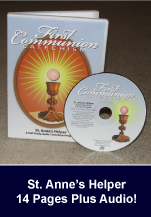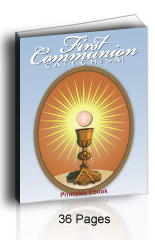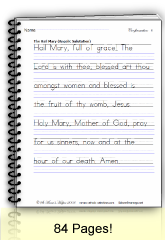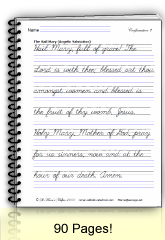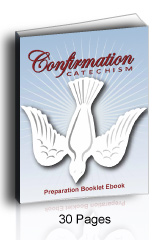President of Ecuador
Gabriel Garcia Moreno Biography
Greatest President Ever.
Not A Historical Re-Write.
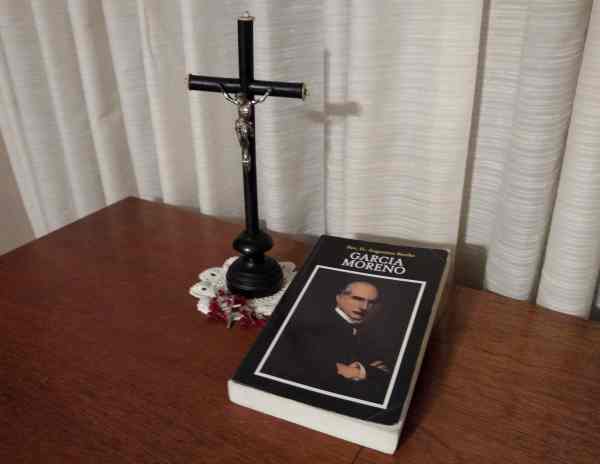 Gabriel Garcia Moreno was president of Ecuador.
Gabriel Garcia Moreno was president of Ecuador.Gabriel Garcia Moreno was the greatest Catholic statesman in Ecuador history. He was eulogized by Pope Pius IX as a martyr after his assassination. He lived from 1821 to 1875 and was elected President of Ecuador twice: first from 1859 to 1865 and second from 1869 to 1875.
His story will give you many insights into our own United States' "American History". In the end he died as martyr for the Catholic religion and his dear country in August of 1875 just after he was elected to his third term as Ecuador President.
The book Garcia Moreno is another rare Catholic book amongst many that publishers are reprinting for our benefit in these days, and it is the best story of Ecuador's history. Thank you Dolorosa Press for reprinting this book. It is so captivating that we devoured it!
This is an excellent book for:
- High school curriculum.
- Those studying politics.
- Catholic reading.
- Pure enjoyment: The underdog conquers his faults, rises to heroism, and wins the eternal battle.
This is an especially good Catholic history book for high school and college.
Timely Journalism On Site
A priest, Rev. Fr. Augustine Berthe, went to the cities in Ecuador where Garcia Moreno had lived and worked. He followed the phenomenal story of Moreno's efforts to lead his people against several Marxist revolutions to a peaceful Catholic life amidst the revolutionary countries that surrounded the country of Ecuador.
Fr. Berthe tells the story where the Ecuadorian provinces faced, not only the destruction common to revolutions, but also the chaos of bandits who had been displaced from their homes. He also told about the Indians who had been unjustly treated by the Protestant sects.
Moreno's rule eventually guided the Ecuadorian government toward peacefully enforcing the Catholic Ten Commandments. It came at a very great price, yet with very great reward for him and his people. The Ecuador government had been held by revolutionaries and was rife with evil as Moreno faced the task of restoring his country.
The book is told from a factual and historical perspective that does not sink to false chivalry, dialog presentation, denigration of women or other classes of people.
Fr. Berthe gives a detailed Ecuador history before he starts Moreno's story which builds the scene that sets the stage for Moreno's heroism.
I treasure that Fr. Berthe interviewed the local people who had been living at the time when Moreno lived. What I love is that this is a simple retelling of what happened.
No opinion or agenda necessary and none given.
Gabriel Garcia Moreno: Best Books For Boys
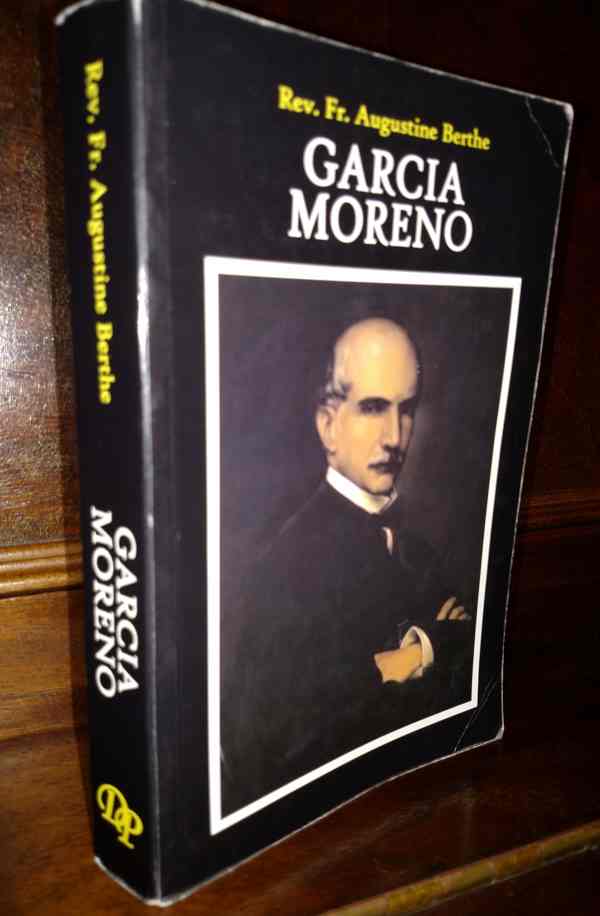 Garcia Moreno by Rev. Fr. Augustine Berthe
Garcia Moreno by Rev. Fr. Augustine BertheMany search for the best books for boys, some books to inspire young men. If this is you, start right here.
Also, ladies and gentlemen will both appreciate the fast action story of this great martyr for the Catholic Faith, who was equal to any of our true Catholic kings and Catholic knights.
Geography Of Ecuador
The author, Fr. Berthe, describes the geography of Ecuador throughout the book giving a glimpse into Ecuador's provinces, but most especially those of Quito, Guayaquil, Vilcabamba, and Ibarra Ecuador. You'll learn the lay of the land with this book as you follow Moreno through his many duties.
Fr. Berthe describes the many times that Gabriel Garcia Moreno and his armies traveled the plains, jungles, and mountains back and forth across the Ecuador map - on foot.
The mountains are as rough as those in our Rocky Mountain Range through the United States of America. The most surprising Ecuador facts that we learned were the vast ranges that the men during the late 1800's traversed on horse and foot, and their huge successes in battle.
Also, the illustrations throughout the book are very inviting.
Where Is Ecuador?
The country of Ecuador is on the continent of South America just south of Columbia and north of Peru and Chile. The map of Ecuador shows twenty four Ecuador provinces:
- Azuay (Cuenca)
- Bolivar (Guraranda)
- Canar
- Carchi
- Chimborazo (Riobamba)
- Cotopaxi
- El Oro
- Esmeraldas
- Galapagos (Yes, the Galapagos Islands)
- Guayas (Guayaquil)
- Imbabura (Ibarra)
- Loja
- Los Rios (Babahoyo)
- Manabi
- Morona Santiago
- Napo
- Orellana
- Pastaza
- Pichincha (Quito is the Ecuador capital)
- Santa Elena
- Santo Domingo de los Tsachilas
- Sucumbios
- Tungurahua
- Zamora-Chinchipe (Zamora)
Why Study Ecuador History & Gabriel Garcia Moreno?
Short answer? Ecuador's history parallels our own United States history and that of most modern nations. One leader like Moreno could repair much in our own country and in others. Long story?
1. Our Lady Of Good Success Foretold Garcia Moreno's Feat
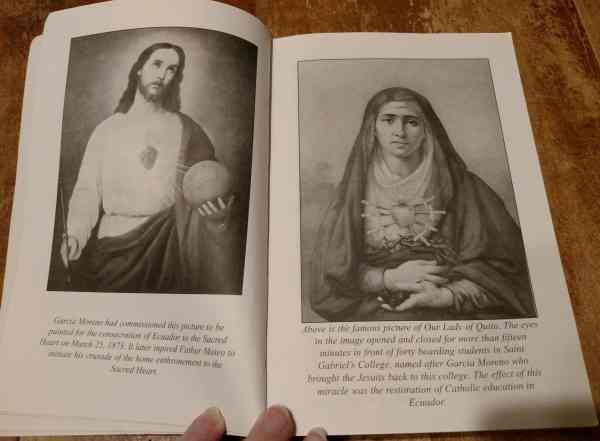 Garcia Moreno consecrated Ecuador to the Sacred Heart of Jesus.
Garcia Moreno consecrated Ecuador to the Sacred Heart of Jesus.The most charming story during the history of Ecuador is the story of Venerable Mother Mariana de Jesus Torres.
Fr. Berthe tells the story about the apparition of Our Lady of Good Success, Our Lady of Quito, who foretold that a Catholic statesman would consecrate the Republic of Ecuador to the Sacred Heart of Jesus. The story is uncanny as it unfolds, especially since Ecuador was not yet a Republic at that time.
President Garcia Moreno did indeed consecrate Ecuador to the Sacred Heart.
2. Garcia Moreno's Story Connects With Our Own Times
Dolorosa Press reprinted this most interesting old Catholic book with a Preface that places the actions of Our Lady and Gabriel Garcia Moreno in the context of Ecuador's history and our own current history.
Dolorosa Press even has current photos of
- Quito's Cathedral and the Plaza de la Indepencia,
- the convent of the sisters,
- and the very places of Gabriel Garcia Moreno's martyrdom.
The Preface tells the prophecies made by Our Lady of Good Success that have been fulfilled and shows the miraculous artifacts that still remain. There are magnificent current photos in the back pages.
3. Proof That The Good Can Win
The rest of the book relates the turbulent history of Ecuador as if Fr. Berthe had been there. Rightly so, since he had used so many and such important eyewitness sources within a short time after the assassination.
Garcia Moreno is one of our favorite traditional Catholic history books - it exemplifies the life of one who came to live and support the Catholic catechism as a hero.
You can buy both the paperback and the hardback Garcia Moreno Biography at Amazon.
Gabriel Garcia Moreno Visitor Comments:
Father Augustine Berthe, CSSR, Garcia Moreno, London, Burns and Oates, 1889, with a Preface by Fr Paul Kimball, 2006 - Dr. Carol Byrne
When Fr Kimball produced this beautifully bound and illustrated book, he did much more than present a biography about the President of Ecuador, Gabriel Garcia Moreno (1821-1875) or a mere history of his tenure of office. He has offered us something more precious: an insight into the past in order to illuminate the present. For the historical events surrounding the life of Garcia Moreno were foretold by Our Lady in the 1600s when she appeared to a Spanish nun, Mother Mariana of Jesus Torres of the Order of the Immaculate Conception in Quito, and spoke of “a truly Catholic President” who would consecrate Ecuador to the Sacred Heart and die as a martyr. Not only are these apparitions declared to be authentic by Bishop Salvador de Ribera of Quito when he formally instituted the official devotion in 1611 and therefore worthy of belief, but Pope Pius IX declared that Gabriel Garcia Moreno “died a victim of the Faith and Christian Charity for his beloved country.”
The book chronicles these events in great detail with authentic contemporary evidence collected by Fr Berthe who lays bare the plot to kill Garcia Moreno: he was assassinated to assuage the vengeful blood lust of local Freemasonic groups who had been continually thwarted by his restoration of Catholic social order in Ecuador.
The book is devoted to the remarkable achievements of Garcia Moreno who inherited a country ravaged by revolution, anarchy and corruption. Within the years of his presidency, he reconstructed it along Catholic lines. Almost the first presidential act he performed was to sign a concordat with the Holy See to protect the Church’s privileges in society. This was followed by a new Constitution which made Catholicism the official religion of the State.
That is precisely what the Social Kingship of Christ entails, that Christ and the laws of the Church be officially recognized by a nation. We can contrast this situation with the present pluralistic, religiously indifferent society deliberately brought about by the Religious Liberty policy of Vatican II. The result is that today not one nation in the world upholds the Catholic Church officially, which has left the Church with no more status or authority in the public life of any country than other religions or atheism.
Garcia Moreno refused to give freedom to evil and to those who wished to attack the Church. He rejected the liberal ideas of the Freemasons who were seeking a complete separation of Church and State, and dedicated Ecuador to the Sacred Heart of Jesus by a government act in 1873. This illustrates the defining feature of his regime: the union of Church and State to guarantee the spiritual and material well being of the people.
In the secular sphere, Gabriel Garcia Moreno set Ecuador on the road to prosperity after decades of revolution and corruption that had bankrupted the country. He reduced taxes and established the Mortgage Credit Bank and several Savings Banks to enable commerce and industry to flourish. He developed roads and railways, founded new schools and universities, encouraged scientific research, improved prison conditions and reformed the judiciary and military.
As a result of his policies, not only was corruption reduced and morals and good customs restored, but property was secure, the nation prospered and social conditions improved. The remarkable thing is that all this was achieved without compromising with the Revolution. That is why Pope Leo XIII hailed Garcia Moreno’s country as “the model of a Christian state.”
But Fr Berthe’s account, excellent though it undoubtedly is, would be incomplete without the other half of Our Lady’s prophesy issued at the same time to Mother Mariana de Torres which effectively links the 19th-century Catholic Statesman of Ecuador to the coming of a “Prelate” during the 20th century to complement his work. As Fr Kimball points out:
“Our Lady prophesied for the twentieth century, saying explicitly that during the nineteenth century and most of the twentieth century, errors would become more and more widespread in Holy Church, placing the Church in a catastrophic situation. Morals would become corrupt and the Faith would disappear.”
This has obviously come to pass as we see that ever since Vatican II the Holy Catholic Church has been afflicted by a crisis of world proportion, heresies abound, the priesthood is wracked by abuses, the light of the Faith is almost extinguished and morals are widely corrupted among Catholics. A Prelate in the 20th century who had the foresight and courage to publicly oppose this wave of apostasy and impiety was Archbishop Lefebvre (1905-1991), Founder of the Society of St Pius X.
In his commentary, Fr Kimball brings convincing evidence to establish a close parallel between the fate of Gabriel Garcia Moreno and Archbishop Lefebvre. Both suffered at the hands of Freemasonry, the former shedding his blood for the Faith, the latter undergoing a dry martyrdom through unmerited persecution, ostracism and eventually excommunication.
Fr Kimball explains:
“Likewise in 1978 Archbishop Lefebvre foresaw who would be the motivators of his excommunication ten years later: "If one day they shall excommunicate us because we remain faithful to these theses we shall consider ourselves excommunicated by Freemasonry. Our consolation will be that we remain in the company of God and of all the martyrs who have given their lives to keep the Faith…
Just as Archbishop Lefebvre drew wrath from the fifth column of Freemasonry within the Church by consecrating four bishops in 1988 as the necessary means of passing down the Catholic priesthood to future generations, so García Moreno had especially angered the Masons by his exemplary Concordat of 1862.”
In making this Biography of Gabriel Garcia Moreno easily available to Catholics today, Fr Kimball has performed a double tour de force: he has kept alive the memory of two outstanding Catholic figures who stood against the Church’s enemies and suffered tragic consequences for their pains. It is a task of monumental importance, for the objective of the 19th-century Freemasons has now been achieved – the subversion of the Catholic Church through the adoption of Masonic principles such as equality of religions, the secular state, the destruction of the sacred liturgy and other compromises with worldly values. Both Garcia Moreno and Archbishop Lefebvre regarded these trends with absolute horror and did battle against them. That is why they suffered at the hands of the Church’s enemies. Yet in spite of all this, Freemasonic principles won adherents among the Catholic hierarchy during Vatican II and Liberalism has gained the ascendancy throughout the entire Church. The rest, as they say, is history.
The general public, not just Catholics, needs to have access to this Biography of Gabriel Garcia Moreno so as to see the underlying reasons for the ills of modern society. They may then be persuaded to look in the right direction for solutions to seemingly insoluble problems and recognise that true peace can only be achieved with the Kingship of Christ. Fr Kimball certainly deserves credit for his wisdom in publishing historical truths which are an inspiration and prophetic sign for our times.
Dr. Carol Byrne
You can also buy the book at Dolorosa Press.com.




